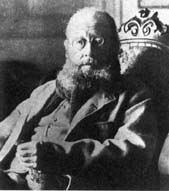
Edward Lear, the last photograph,
taken in 1887

Edward Lear, the last photograph,
taken in 1887
Victorian Trickster:
A Jungian Consideration of Edward Lear's Nonsense Verse
The foremost Lear scholar, Vivien Noakes, has pointed out that "When Lear was first writing there was no such thing as an established literary genre of nonsense" (Wanderer 223). Why, then, should not one but two men writing in the mid-1800s simultaneously yet apparently without knowledge of each other introduce into English letters what amounted to a new genre, one that has never lost its popularity?1 The Victorian collective psyche must have been ready, somehow, to respond to the irrational characters and patterns depicted in the Alice stories and in Lear's nonsense limericks, songs, and stories. In his book, Art and the Creative Unconscious, the eminent Jungian analyst, Erich Neumann, has noted that "the creative impulse springs from the collective" (98), and that "although creative men usually live unknown to one another, without influence on one another, a common force seems to drive all those men who ever compensate for a cultural canon at a given time or shape a new one" (99). Such is the case with Carroll and Lear. Alice has been analyzed from a Jungian point of view (Bloomingdale 378-390).2 More analysis needs to be done on Carroll. However, no Jungian interpretation has yet been applied to Lear, and I propose such an interpretation here.
Comparing Carroll with Lear, John Lehmann notes that Carroll's "brand of nonsense is undoubtedly more intellectual" than that of Lear, who "has a vein of tender and often melancholic feeling that is nowhere to be found in Carroll's Alice books [. . .] (50). "All nonsense," says Lehmann, "[. . .] is a parody or standing-on-its-head of the strict and rational world in which we have to live, and so momentarily releases us from its chains" (51). That the Victorian world was in turmoil over scientific ideas which seemed inimical to traditional religious faith, ideas such as those proposed in Darwin's Origin of Species (1859), is a given about the period. From the Jungian point of view, the seemingly irrational nonsense of Carroll and Lear compensated for an increasingly rational Victorian Zeitgeist and this compensation helps account for the popularity of the work. Furthermore, nonsense provided a healthy antidote for Victorian earnestness, the same kind of palatable medicine provided by Wilde's The Importance of Being Earnest in the 1890s. As traditional religious and social structures have broken down throughout the nineteenth and twentieth centuries, and since we no longer have a collective myth to rely on or emulate for personal growth, irrational stories and images from both popular and elite art have remained appealing.3 Among these stories and images are the works of Carroll and Lear, which, as I've noted, have never lost their popularity. Although a strictly biographical interpretation of Lear's nonsense would deprive the work of its full archetypal, and hence collective, meaning, a brief examination of Lear's personal psychology may help to show why he was especially suited to produce the work. What is needed also is an examination of the rich archetypal material Lear unconsciously produced, material which makes his work visionary in the sense Jung uses the word ("Psychology and Literature" 89). As we shall see, the chief archetype Lear represents is the Trickster.
I
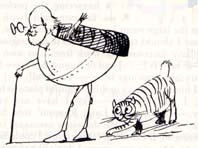
From a letter to Amelia Edwards,
18 October 1885, self-caricature of
Lear and his cat, Foss, San Remo
One must be very careful examining an artist's personal life in order to amplify his work. Even the most fully documented life may contain secrets known only to the man or woman who lived the life. Jung himself, for instance, was sexually assaulted as a child by an esteemed adult male, yet no biographer--and certainly not Jung himself--has ever identified the man or the circumstances nor tried fully to explore the affects the experience had on Jung (see Brome 121-122, Downing 93-94, and Smith 34). Lear too, in the words of a recent biographer, "was almost certainly sexually abused [at the age of nine] by a young man called Frederick Harding," who was nineteen at the time (Chitty 14). Like Jung's biographers, Lear's have been unable to analyze the effects of such childhood experience, effects which must have been extremely traumatic. Indeed, Lear's first biographer, Angus Davidson, fails even to mention Harding's name.
Lear was raised by women. The twentieth of twenty-one children, he was raised mostly by his sister, Ann, who was twenty-two years older than he. Though he was devoted to Ann, it was she who instilled an almost lifetime guilt over his relatively mild epilepsy. "She told him," Chitty writes, "that 'The Demon,' as he always called his [epileptic] attacks, came to little boys because they played with themselves." Despite "this dire warning, Lear found it impossible to exercise self-control. [. . .] Only towards the end of his life did Lear begin to suspect that there might be no connection between masturbation and fits" (13). An easy, possibly Freudian, interpretation of Lear's lifelong preoccupation with noses might be based on his masturbatory guilt. Take, for example, this limerick:
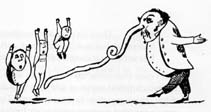
All drawings for the limericks are by
Lear.
There was an Old Man with
a nose,
Who said, "If you choose
to suppose
That my nose is too long,
You are certainly wrong!"
That remarkable man with
a nose.4
Lear's illustration for this limerick shows a man with an incredibly long nose, curled like a snake, thrust toward three youngsters, all leaping with their hands up in the air and expressions of fright and pain on their faces. The phallic symbolism is unmistakable, and it is worth noting that an "enormous penis" is an important physical attribute of the Trickster archetype (Radin 165-66). The Old Man of the limerick projects his own fear, pain, and guilt onto the frightened children. However, women too in Lear's limericks have long, unruly noses:
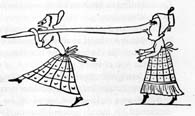
There was a Young Lady
whose
nose
Was so long that it reached
to her toes;
So she hired an old lady,
Whose conduct was steady,
To carry that wonderful
nose.
Lear may be unconsciously projecting an image of his sister Ann onto this Young Lady with her phallic nose, but Lear is also, like the Trickster, opening up "boundaries," to use Karl Kerényi's word from his commentary on the Trickster, whose "inordinate phallicism cannot limit itself to one sex alone" (188). Lear's treatment of noses has deep psychological significance, upon which I will expand latter. For now, it is enough to conclude that he was able to turn his guilt into creative use and thus, at least in a small way, to compensate personally for the guilt while at the same time entertaining countless readers, children as well as adults.
Lear was, in many ways, an example of what Jungian psychologist Marie-Louise von Franz calls the puer aeternus,an archetype she analyzes in her book of the same name. The term comes from Ovid's Metamorphoses and there refers to the child-god of the Eleusinian mysteries. "In later times," von Franz writes,
the child-god was
identified
with Dionysus and the
god Eros. He is the divine
youth who is born in the
night in this typical
mother-cult
mystery of Eleusis,
and who is a redeemer. He
is a god of life, death and
resurrection--the god of
divine youth [. . .] The title
puer aeternus
therefore
means "eternal youth," but
we also use it to indicate
a certain type of young man
who has an outstanding
mother
complex [. . .] . (1)
Von Franz maintains that "the man who is identified with the archetype of the puer aeternus remains too long in adolescent psychology," retaining "all those characteristics that are normal in a youth of seventeen or eighteen [. . .] coupled in most cases with too great a dependence on the mother." Typically, such a man is either a homosexual or a Don Juan (1), though it would be a serious mistake to say all homosexuals fit this profile. The Don Juan is never able to commit himself to any woman. Lear, a homosexual, does not fit this pattern, though during times of great despair, he sometimes thought of marrying a woman who could nurture him and alleviate his loneliness (Noakes, Wanderer 58, and Chitty 58 and 142). Contributing to his loneliness was the fact that he kept his epilepsy hidden from others.
Lear did, however, lead what H. G. Baynes called the "provisional life" (qtd. in von Franz 2). For the Don Juan, this is a refusal to accept any one woman, with the hope, as von Franz puts it, that "in the future the real thing will come about." There is, she says, "a terrific fear of being pinned down, of entering space and time completely, and of being the specific human being that one is" (2). This aspect of the puer aeternus archetype helps explain Lear's constant traveling. Even after he settled in San Remo, Italy, at the age of fifty-eight, he made an arduous trip to India and continued his travels around Europe. In his early career, he had traveled to many of the same places Byron--another puer aeternus--had been, places such as Albania and Greece. Indeed, Byron had been a childhood hero who had died when Lear was eleven. Years later Lear wrote in his diary about how he used to "sit [. . .] in the cold looking at the stars [. . .] stupefied & crying" when he "heard that Ld. Byron was dead" (qtd. in Noakes, Wanderer 22).
There are other explanations for Lear's traveling. As a landscape painter, he needed new subjects. Furthermore, as Noakes shows, "he saw that, for all his suffering, the world was full of beauty and wonder. Above all, he found in these journeys a physical and spiritual freedom he had never imagined possible and which he sought to share in his Nonsense songs" (Edward Lear: 1812-1888 14), for journeys are a frequent motif in his nonsense verse. Wandering, moreover, is one of the most important traits of the Trickster archetype (Radin 167), which, as we shall see, Lear's nonsense exemplifies. Another reason for Lear's traveling was the fact that "being on the move helped to reduce the frequency of his epileptic attacks, and although the rigorous journeys sometimes exhausted him, he never felt fitter than when he was traveling" (Noakes, Lear, Selected Letters xvi).
Lear's physical traveling is symbolic of his quest for spiritual fulfillment, specifically his quest for a companion. Unlike the Don Juan, and as Noakes writes,
his search wasn't for
physical
love, but for someone
who would want him as a
person in the way that his
parents had not wanted him
as a child. Through his
sensibility and charm he
was sought after as a friend,
and he loved to be with
children because they liked him
and showed it. But what
he was searching for, and
never found, was real
spiritual
involvement with
another person.
(Wanderer 134)
Unlike Lewis Carroll, who sought in little girls the companionship he needed, Lear sought his in young men, Franklin Lushington in particular, and in later life Hubert Congreve. Sadly the love was never returned in the way Lear longed for. Noakes is right, I think, that Lear "was not a philandering homosexual" (ibid. 134), but the love he sought surely needed a physical as well as a spiritual fulfillment.5
Although he lived in an entirely different social and cultural context, Lear in some respects resembled, through the role he played, the American Indian berdache. Early European explorers considered the berdaches abhorrent "sodomites," whose existence they tried to extinguish. They were men who in various tribes fit into "an alternative gender role that is a mixture of diverse elements." In his definitive work on berdaches, The Spirit and the Flesh,Walter L. Williams defines a berdache "as a morphological male who does not fill a society's standard man's role, who has a nonmasculine character" (2). Williams further comments: "Berdaches gain social prestige by their spiritual, intellectual, or craftwork/artistic contributions, and by their reputation for hard work and generosity" (2). In many tribes, berdaches are "powerful shamans"; they have "sacred powers to doctor illnesses" (35). Williams quotes a Navajo woman, niece of "a well respected nadle [Navajo word for berdache] healer":
They are seen as very
compassionate
people, who care for
their family a lot and help
people. That's why they are
healers. Nadlesare
also seen as being great with children,
real Pied Pipers. Children
love nadles , so parents are
pleased if a nadletakes
an interest in their child. (54)
"Berdaches," writes Williams, "are recognized as having a special talent in educating children" (55).
Furthermore, "joking and kidding around" is an essential part of Indian society (Williams 40). If you are kidded, that shows you are accepted, and the berdache, though often the object of ridicule, is at the same time honored as one with a unique spiritual role in society (41). One Pueblo berdache is "a member of the Clown Society [. . . whose] job is to provide comic relief during the serious religious ceremonies" (113). Without pressing the comparison too far, one might say that, similarly, nonsense writers like Carroll and Lear provided comic relief for an entire society.
Another aspect of the berdache was that it was considered an honor for a berdache to confer on a boy a sacred and secret name (37). Fathers often sought such an honor for their sons by flirting and having sex with the berdache (37 and 107).
Although Williams does not draw comparisons, the
role of the berdache in Indian society is similar in many ways to that
of the mythical Trickster. The Trickster has the ability to move freely
between male and female genders, to become, like the berdache, a
"man-woman"
(Radin 138; Radin, however, fails to note the parallel between the
Trickster
and the berdache). Like the berdache, Lear was a hard worker,
especially
close to women (note his relationship to his sister Ann and his deep
friendship
with Emily Tennyson), and a homosexual. Lear's role (what Jung
calls
the persona) was like that of the berdache in his contributions as a
visual
artist, his appeal to children, his offering of healing laughter (both
in personal relationships and in his nonsense writings), and even in
his
name-giving ability. Consider Lear's many coined names: the Pobble who
has no toes, the Jumblies, the Quangle Wangle Quee, the Dong with a
luminous
nose, and the Yonghy-Bonghy-Bò, to cite only a few. The names
are
not secret, but their meanings are.
The berdache shares with the puer aeternusa positive aspect: a "certain kind of spirituality which comes from a relatively close contact with the collective unconscious. Many [pueri aeterni] have the charm of youth and the stirring quality of a drink of champagne [. . . They] are generally very agreeable to talk with [. . .]" (von Franz 4). Von Franz's description applies certainly to Lear. Just as every biographer speaks of the sadness and loneliness in Lear's life, they all too speak of his personal charm and ability to make others laugh.
Lear lived in an age that especially needed to laugh. The Evangelical church, as Noakes observes, had a "pervasive" influence which "spread upwards through society as the century progressed." Evangelicals preached the denial of virtually everything that was fun, or Dionysian, in life: "Such denial began in earliest childhood [. . .] joy was synonymous with levity, and merriment was a step along the broad road to destruction [. . .]" (Edward Lear: 1812-1888 13). Noakes quotes Lear: "'When will it please God to knock Religion on the head & substitute charity, love & common sense?'" To a little girl he wrote: "'My dear child, I'm sure we shall be allowed to laugh in Heaven!'" (qtd. in Edward Lear: 1812-1888 13). Furthermore, Noakes declares:
In the limericks [. . .]
to an extent difficult for us now
to imagine, Lear offered
children the liberation of
unaffected high spirits
[. . .]. Here are grown-ups
doing silly things, the
kind of things grown-ups
never do [. . .]. for all
their incongruity, there is in
the limericks a truth which
is lacking in the improving
literature of the time.
In an age when children were
loaded with shame, Lear
attempted to free them
from it. (Edward Lear:
1812-1888 13-14)
The function of the Trickster, according to Kerényi, "is to add disorder to order and so make a whole, to render possible, within the fixed bounds of what is permitted, an experience of what is not permitted" (185). Kerényi could just as well be describing the nonsense genre that emerged in the nineteenth century.
Lear's nonsense songs continue the "message of tolerance and understanding," adding to it "the excitement of opening one's eyes and exploring the world around, of discovering undreamt-of lands and wonders not only unseen but scarcely even imagined" (Edward Lear: 1812-1888 14).6 The Alice books of Carroll, of course, do the same, although Alice herself (if not always the characters she encounters) is more concerned with social propriety than are Lear's characters. Jung's belief that visionary literature compensates for contemporary imbalance applies equally to the work of both Lear and Carroll.
II
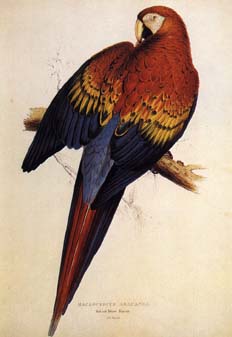
Red and Yellow Macaw, painting by
Edward Lear
Lear began his career at fourteen, drawing flowers, butterflies, and birds, especially parrots (Chitty 18-22). Although Lear first published his limericks in A Book of Nonsense in 1846, he had begun writing them a decade earlier at the Earl of Derby's Knowsley Hall, where he had gone to draw Lord Stanley's private menagerie. One hundred and twenty-eight limericks survive in the Knowsley Album of about 1837 (Chitty 29). The limerick (the name itself, according to the Oxford English Dictionary, did not enter the language till 1898), was not new, but Lear popularized the form, and among the writers of "dirty limericks" are such renowned poets as Tennyson, Browning, and Swinburne (Chitty 30).
Lear's published limericks are not, as such, "dirty," but they certainly were an antidote to the restrictive education Victorian children were subjected to. Lear's limericks are, indeed, an unconscious revival of the Trickster archetype. Paul Radin, in his famous study of the Trickster as he appears in the Winnebago tribe of central Wisconsin and eastern Nebraska, sums up his traits thus:
Trickster is at one and
the
same time creator and destroyer,
giver and negator, he who
dupes others and who is always
duped himself. He wills
nothing consciously. At all times
he is constrained to behave
as he does from impulses over
which he has no control.
He knows neither good nor evil
yet he is responsible for
both. He possesses no values,
moral or social, is at the
mercy of his passions and
appetites, yet through his
actions all values come into
being. (xxiii)
"Many of the Trickster's traits," Radin writes, "were perpetuated in the figure of the mediaeval jester, and have survived right up to the present day in the Punch-and-Judy plays and in the clown" (xxiii). As early as 1907 a critic commented that Lear "jingled the jester's bells" (Baring 255). Although the Trickster is often
identified with specific
animals, such as raven, coyote,
hare, spider [. . .] he
is primarily an inchoate being of
undetermined proportions,
a figure foreshadowing the
shape of man. In this
version
he possesses intestines
wrapped around his body,
and an equally long penis,
likewise wrapped around
his body with his scrotum
on top of it. Yet regarding
his specific features we are,
significantly enough, told
nothing. (Radin xxiii-xxiv)
Furthermore, "Laughter, humour and irony permeate everything Trickster does. The reaction of the audience in aboriginal societies to both him and his exploits is prevailingly one of laughter tempered by awe" (xxiv). One can imagine Victorian children, not to mention adults, having the same kind of reaction to Lear's limericks and later his nonsense songs.
The specific antics and characters in Lear's nonsense may not always match those in the myths, but the compensatory function is identical. Here are some of the themes in Lear's limericks (from A Book of Nonsense and More Nonsense,1862): exclusion, self-consciousness (represented especially by noses), despair, cruelty, punishment, bad manners, embarrassment, shyness, uncontrolled bodily parts (hair, noses, etc.), exceptional skill or ability, and the ridiculous. The very first limerick combines several of these themes--self-consciousness, embarrassment, uncontrolled bodily parts, and the ridiculous:

There was an Old Man with
a beard,
Who said, "It is just as
I feared!--
Two Owls and a Hen,
Four Larks and a Wren,
Have all built their nests
in my beard!"
What better parody of the great beards Victorian men (Lear included) liked to grow! The women and their enormous hats are also made fun of:
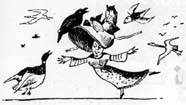
There was a Young Lady
whose
bonnet
Came untied when the birds
sat upon it;
But she said, "I don't care!
All the birds in the air
Are welcome to sit on my
bonnet!"
One can imagine the delight Victorian children had being able to laugh thus at their elders with impunity.
The raven or crow is one of the animals Radin cites as connected with the Winnebago Trickster. Indeed, Raven is the actual name of the Trickster in the Tlingit version of the myth (Radin 104-108.) This archetypal image appears in more than one of Lear's limericks:
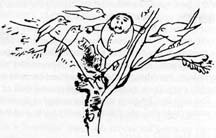
There was an Old Man of
Dundee
Who frequented the top of
a tree;
When disturbed by the crows,
He abruptly arose,
And exclaimed, "I'll return
to Dundee."
The "Old Man" in the following limerick doesn't fare so well:

There was an Old Man of
Whitehaven,
Who danced a quadrille with
a raven;
But they said, "It's absurd
To encourage this bird!"
So they smashed that Old
Man of Whitehaven.
Punishment and cruelty, as well as the absurd and the ridiculous, are themes of these limericks.
Sometimes the birds are simply pleasant companions:

There was an Old Person
of
Hove,
Who frequented the depths
of a grove;
Where he studied his Books,
With the Wrens and the Rooks,
That tranquil Old Person
of Hove.
Similarly, the embarrassingly large nose can be turned into an asset:
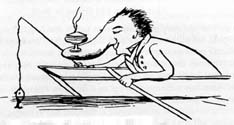
There was an Old Man in a
Barge,
Whose Nose was exceedingly
large;
But in fishing by night,
It supported a light,
Which helped that Old Man
in a Barge.
Lear's emphasis on phallic noses is an unconscious assertion of one of the Trickster's "primary traits [. . .] his unbridled sexuality" (Radin 167). Lear thus, again unconsciously, symbolizes what Kerényi calls the Trickster's "true nature": "the spirit of disorder, the enemy of boundaries" (185, italics Kerényi's). In a sense, this is the true spirit of all nonsense--a compensation for all artificial strictures, a joyous release from inhibitions.
One misses, of course, half the impact of the limericks if one does not see Lear's accompanying drawings. Take, for example, the following, in which an insect clearly has the menacing aspect of the Trickster:
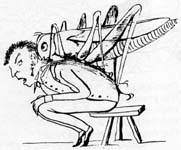
There was an Old Person
in
Black,
A Grasshopper jumped on
his back;
When it chirped in his ear,
He was smitten with fear,
That helpless Old Person
in Black.
This isn't an ordinary grasshopper: in Lear's drawing, it's a grasshopper quite as large as the man on whose back it perches, and it seems almost to be biting the man's neck as much as chirping into his ear.
Whereas the Winnebago Trickster can have his "intestines wrapped around his body, and an equally long penis, likewise wrapped around his body" (Radin xxiv), Lear has a man (another of his old persons, generic symbols for all adults) coiled up as if he were a serpent or, indeed, a long intestine or penis:
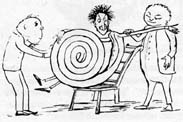
There was an Old Person
of
Pinner,
As thin as a lath, if not
thinner;
They dressed him in white,
And roll'd him up tight,
That elastic Old Person
of Pinner.
This old man, like many others in Lear's limericks, is an outsider, excluded from the common run of human beings because of some physical difference.
In his commentary on Radin's study of the Winnebago Trickster cycle, Jung suggests that the myth is "the reflection of an earlier, rudimentary stage of consciousness," one which appears clinically as a "split-off personality [that] is not just a random one, but stands in a complementary or compensatory relationship to the ego-personality. It is a personification of traits of character which are sometimes worse and sometimes better than those the ego-personality possesses" (The Archetypes 261). The Trickster is, in other words, a manifestation of what Jung calls the shadow; and he comments: "We are no longer aware that in carnival customs and the like there are remnants of a collective shadow which prove that the personal shadow is in part descended from a numinous collective figure" (ibid.262), from, that is, the Trickster archetype.
Furthermore, the Trickster
is a forerunner of the
saviour,
and, like him, God,
man, and animal at once.
He is both subhuman and
superhuman, a bestial and
divine being, whose chief
and most alarming
characteristic
is his unconscious-
ness [. . .]. He is so
unconscious
of himself that his body
is not a unity, and his
two hands fight each other. He
takes his anus off and
entrusts
it with a special task.
Even his sex is optional
despite its phallic qualities:
he can turn himself into
a woman and bear children. (ibid. 263)
Victorian propriety, of course, prevented Lear from showing the removal of an anus or a penis, but Lear has a man (an "Old Man," naturally) who sharpens his nails so hard with a file that he cuts off his thumbs. Then there is the "Young Person of Janina, / Whose uncle was always a-fanning her; / When he fanned off her head, / She smiled sweetly and said, / 'You propitious Old Person of Janina!'" As Jung says of the Trickster: "Although he is not really evil, he does the most atrocious things from sheer unconsciousness and unrelatedness" (ibid. 264).
The creative aspect of the Trickster is suggested by the following limerick, which contains another of the animals Radin connects with the archetype:

There was an Old Person
whose
habits
Induced him to feed upon
rabbits;
When he'd eaten eighteen
He turned perfectly green,
Upon which he relinquished
those habits.
Lear's illustration shows a rabbit emerging from the mouth of this exceptionally hungry and large old man--clearly a parody of the birthing process. This limerick also exhibits another of the Trickster's most important traits--"his voracious appetite." In fact, Lear's nonsense portrays all of the Trickster's "primary traits" that Radin cites, his enormous appetite, as well as "his wandering and his unbridled sexuality" (167).
The Trickster, like Merlin, the alchemical Mercurius, and other Trickster-like figures, is a shape-changer, often identified in Indian myths as various animals. All kinds of animals--bees, fleas, spiders, owls, geese, cats, dogs, pigs, and so on--appear in Lear's limericks. And Lear's nonsense songs, stories, and alphabets contain an even wider variety, from kangaroos, pelicans, guinea pigs, and storks in the songs and stories to the bear, the quail, the ape, the kingfisher, the rattlesnake, the yak, the zebra, and many others, in the alphabets.
"Outwardly," Jung writes, "people are more or less civilized, but inwardly they are still primitives," and the Trickster is "a collective shadow figure, a summation of all the inferior traits of character in individuals. And since the individual shadow is never absent as a component of personality, the collective figure can construct itself out of it continually" (The Archetypes 269). However, as Jung asserts and as is true of every archetype, there are two sides to the shadow, which "although by definition a negative figure, sometimes has certain clearly discernible traits and associations which point to a quite different background" (ibid. 270). Accommodating the shadow can lead to the next stage of the individuation process: the encounter with the contrasexual, the anima or the animus. On the collective level, however, the numinous quality Lear's work provides comes more in the nature of an antidote to Victorian (and modern) hyper-rationalism and repressiveness.
Comedy has always contained a certain amount of cruelty or meanness--shadow qualities--and this is certainly true in Lear's nonsense. Victorian children, little and grownup, could project their shadows onto the many victims in the limericks and onto those who punish them with impunity. The "Young Lady of Greenwich," for instance, "Whose garments were border'd with Spinach," has "a large spotty Calf [. . . bite] her Shawl quite in half [. . .]." And the "Old Person of Cheadle" is "put in the stocks by the beadle / For stealing some pigs, / Some coats, and some wigs [. . .]." Noakes believes that "one of the characteristics of pure nonsense is detachment--neither the writer nor the reader is to be involved with the characters" (Wanderer 224). However, I believe that the detachment, if such it is, is merely on the conscious level. Unconsciously we are affected, for we are, be we child or adult, responding to archetypal contents.
III
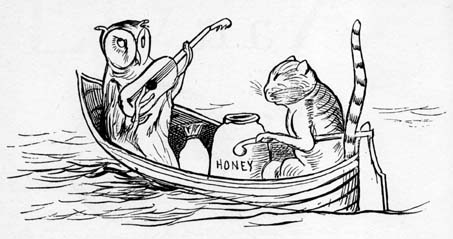
Lear's drawing of The Owl and the Pussy-Cat
Lear's most popular longer poems are also manifestations of the Trickster archetype. "The Owl and the Pussy-Cat," perhaps Lear's most famous nonsense poem, was inspired, like Carroll's Alice books, by a particular little girl. The girl was Janet Symonds, daughter of the Victorian man of letters and friend of Lear, John Addington Symonds (Davidson 171).7 In his commentary on the Trickster Jung notes "the polaristic structure of the psyche, which like any other energic system is dependent on the tension of opposites" (The Archetypes 269). The Owl and the Pussy-cat are clearly opposites--a bird and a mammal (the first of several unlikely couples in the nonsense songs; other examples include "The Duck and the Kangaroo," the Pelican and the Crane, and "The Daddy Long-Legs and the Fly"). The cat is usually a feminine symbol and the owl is more usually masculine--a bird and thus a figure from the sky, and wise. Both are important in Egyptian mythology, the cat being "sacred to the goddesses Isis and Bast" (Cirlot 39) and the owl symbolic, ironically, of "death, night, cold and passivity," though "it also pertains to the realm of the dead sun, that is, of the sun which has set below the horizon and which is crossing the lake or sea of darkness" (Cirlot 247). The unlikely couple are assisted in their marriage by another mammal (a "Piggy-wig" who sells them for a shilling the "ring at the end of his nose") and another bird--"the Turkey who lives on the hill," that is, above things, closer to the sky, unlike the chthonic Pig, who comes from a "wood."
As Thomas Byrom has observed: "The landscape [of the poem] is familiar Romantic stock: the sea, the wood, the shore, illuminated by starlight and moonlight" (159). However, as Byrom further notes, instead of the masculine owl proposing, as we would expect, "it is she [the Cat] who proposes, and in the picture in which the Owl gets the ring from the Pig, the Owl looks very timid, bashful even, while the Cat towers over him and looks down with a severe, even predatory glare" (159). The role reversal is similar to that of the Winnebago Trickster in the episode where he becomes a woman and courts the "chief's son" (Radin 23). And of course we know that "cats eat birds" (Byrom 160). The implication is that the marriage could end in death. However, despite these and other incongruities, the ending is happy: "They danced by the light of the moon" (Lear 253). The cat, in Egyptian mythology, is associated with the moon (Cirlot 39). The whole setting, as Byrom notes, is typical of "nursery rhymes, ballads, [and] the literature of quest" (159), and it is symbolic of the unconscious, and thus an indication that we are dealing with symbolic, archetypal contents.8 That roles are reversed is a "trick" of the Trickster, just as the improbable coupling and other characters are. Things are not as they seem is the implicit message--just as the rational, severe, drab, and indeed often desperate surface of contemporary civilization was not the ultimate reality. Here the Trickster's role as "forerunner of the saviour" (Jung, The Archetypes 263) is operative. The berdache's role as "mediator between the polarities of woman and man" (Williams 21), as well as "between the psychic and the physical--the spirit and the flesh" (Williams 41) is also operative. Unlike other of Lear's nonsense ballads, this one ends happily, with the opposites united.
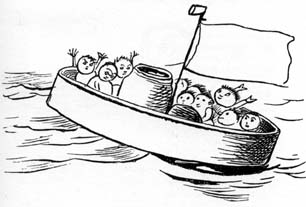
Lear's drawing of The Jumblies
Another of Lear's most popular nonsense songs is "The Jumblies," in which a group of Jumblies go "to sea in a Sieve" (264), an impossibility in the "real," physical, rational world. But we are not, obviously, in such a real world. We are in a nonsensical world which makes psychic sense--a world of archetypal images, so the fact that the Sieve is round, an archetypal symbol of wholeness--a mandala--is not accidental. We have, indeed, a collective hero's journey to wholeness, a nekyia or night sea journey such as Odysseus and countless other heroes have taken. For although the Jumblies begin their perilous voyage "On a winter's morn, on a stormy day" (264), the poem emphasizes the darkness of the sky, the length of the voyage, and the night: "And all night long they sailed away" (266). The Jumblies themselves repeat the emphasis: "'And all night long in the moonlight pale, / We sail away with a pea-green sail [. . .]'" (267).
They are in the world of the "all-devouring Terrible Mother," as Jung says about the nekyia in another context (Symbols of Transformation 316), threatened by the sea water. To protect themselves, "they wrapped their feet/In a pinky paper all folded neat, / And they fastened it down with a pin" (266). As ridiculous as this sounds, it is no more ridiculous than the Winnebago Trickster's sending his detached penis in a box across a lake. The box keeps sinking because Trickster has tied a stone around the "neck" of his penis. On his fourth attempt (the number four is archetypally significant as a number of wholeness), Trickster finds the right size stone, attaches it to his penis, and "this time it went directly towards the designated place," which happens to be the chief's daughter, with whom he wishes to have intercourse, and does (Radin 19).
The Jumblies, on the other hand, sail "to the Western Sea [. . .] To a land all covered with trees" (267). There they buy all sorts of odd things (an Owl, a Cart, a pound of Rice, a "hive of silvery Bees," "a lovely Monkey with lollipop paws," and so forth), and they settle down. The "Western Sea" may symbolize the hope and promise of the New World with its "land all covered with trees."
In any case, Byrom classifies "The Jumblies" and "The Quangle Wangle's Hat" as Lear's "paradise poems" (208). And indeed, the Quangle Wangle's hat as depicted by Lear is another mandala, one upon which alight a fantastic assortment of the kind only an Edward Lear could invent: there are "Mr. and Mrs. Canary," "the Stork, the Duck, and the Owl; / The Snail and the Bumble-Bee, /The Frog, and the Fimble Fowl [. . .] And the Golden Grouse [. . .] And the Pobble who has no toes,-- / And the small Olympian bear," and several other fantastic creatures. In his book, Longing for Paradise , Jungian analyst Mario Jacoby writes: "The perspective of depth psychology links ideas of Paradise [. . .] with the pre-conscious state of infancy, when the ego as the center of human consciousness has not yet been activated" (7). This pre-conscious state is one of the attributes of the Trickster.
In addition, nostalgia, the kind implicit in these nonsense poems, "is the longing for oneness with the mother in a state of problem-free containment, where total harmony, full accord, utter security and consolation reign supreme" (Jacoby 7). (Robert Louis Stevenson's A Child's Garden of Verses and the poems of A. E. Housman evoke a similar sort of nostalgia.) Byrom notes, the paradise in both poems is not without sadness. There are obstacles to overcome. The Quangle Wangle is quite lonely until his odd menagerie joins him. But in the end, "all were as happy as happy could be, / With the Quangle Wangle Quee" (335). Victorian children had often to grow up or leave the family quicker than today's children, either by being sent to work early if they were poor or by being sent off to public school if they were boys from well-off families. Being torn from the comforts of mother and home so quickly, they would have responded with pleasure to Lear's paradise poems. Even if they stayed at home, as would have been the case with girls from affluent homes, they would have unconsciously and nostalgically been drawn to the rather carefree world Lear portrays, just as Victorian adults may also have been drawn to the same crazy, whimsical world.
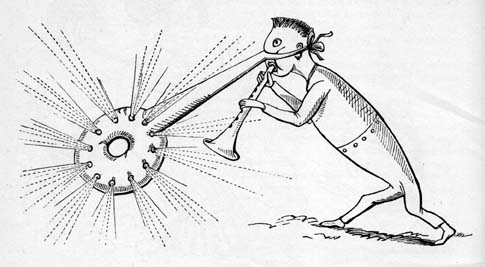
Lear's drawing of The Dong with a Luminous Nose
One of the creatures who takes refuge in the Quangle Wangle's hat is "the Dong with a luminous nose." In the poem of the same name, "the last of his great Nonsense songs," written about 1876 (Noakes, Edward Lear: 1812-1888 177), the Dong does not fare so well. He comes to grief because he falls in love with a Jumbly Girl, a femme fatale who arrives with the Jumblies in their Sieve. For a while all goes fairly well: "They danced in circlets all night long, / To the plaintive pipe of the lively Dong." This goes on "Till the morning came of that hateful day / When the Jumblies sailed in their Sieve away, / And the Dong was left on the cruel shore / Gazing--gazing for evermore" (Lear 292-293), not unlike the rejected lover in Swinburne's "The Triumph of Time." The Dong departs on his own fruitless quest, searching for his lost love, making for himself his incredible nose:
A
Nose as strange as a Nose could be!
Of vast proportions and
painted red,
And tied with cords to the
back of his head.
--In a hollow rounded space it ended
With a luminous lamp within suspended
All fenced about
With a bandage stout
To prevent the wind from blowing it out;--
And with holes all round
to send the light,
In gleaming rays on the
dismal night. (294)
Although the end of the nose is round like a mandala, there is no psychic wholeness for the Dong. All night and every night "he seeks, but seeks in vain / To meet with his Jumbly Girl again; / Lonely and wild--all night he goes,-- / The Dong with a luminous nose!" (295).
The Freudian implications are obvious. As Byrom declares: "Any poet writing after the publication of Freud's Interpretation of Dreamswould have dispensed with the Nose as too obvious [. . .] The fear of sexuality, and of sexual inadequacy in particular, has floated to the surface" (177). Perhaps Byrom is right, too, in his belief that
The poem is an honest
account
of Lear's failure to find
in love or nature the
wonderful
assurances which
Romantic tradition had
promised.
The pastoral is
deserted, the paradise is
purgatorial, love is
ruined, the sublime is
bathetic.
But the best
and most intense nonsense
is in the admirable,
recreative courage of the
Dong, who pursues his
quest beyond all reason,
believing by virtue of
the absurd, where he cannot
see or fairly hope. (178)
So far as a biographical interpretation goes, Byrom is probably right.
However, perhaps there is a wider, collective meaning. The Oxford English Dictionarydefines "dong" as "an imitation of the deep sound of a large bell." It is also an obsolete "form of dung."9 With his penchant for coined words, Lear probably had neither of these definitions in mind. Nevertheless, both meanings resonate with impact and connotations, even if we take the nose to be a phallic symbol. Byrom comments that "Lear is afraid that his art has failed" (178) in this poem. Lear's persona, his public role by which he earned his living, was that of landscape painter. The persona is the mask we wear before the world, and the Dong's nose is described and drawn by Lear as a mask. Lear does indeed project this persona onto the nose. Another of Lear's personas, one not public at all but one intimately connected to his ego, was that of a homosexual man. It is not too much, then, to interpret the nose as a projection of these personas of Lear. The phallicism of the nose fits here as well, for it represents his homosexuality. Kerényi goes so far as to declare: "The phallus is Trickster's double and alter ego," (182).
Lear felt excluded from "normal" society. Yet "normal" society needed a corrective to its suppression and fear of all forms of sexuality. Here is where the collective aspect of this nose (and by extension all of Lear's other phallic noses) comes into play. The spectacular, albeit subliminal, display of sexuality compensates not just for Lear's own inhibitions but also for those of Victorian society as well. He is shouting, as it were: "I exist. I am an artist. I am a sexual being. I am a man who loves men. I am frustrated. See what happens when a person's need for love is not fulfilled!" His personal declaration, however unconscious, speaks for all his readers too. G. A. Gaskell's definition of the nose as "symbolic of volition and free-will" (540) is relevant here, for at least on the surface Victorians, and especially homosexual Victorians, had to stifle their free-will when it came to matters of sex.10 Again, the Trickster, with all his deviousness, all his sensuality and his sexuality, is showing his face in the guise of innocuous nonsense poetry.
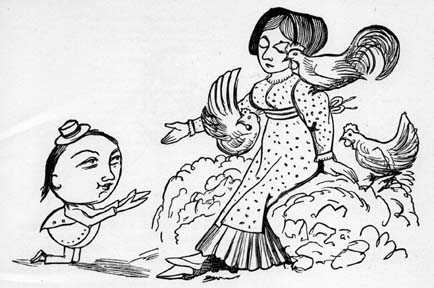
Lear's drawing for "The Courtship of the Yonghy-Bonghy-Bò"
"The Courtship of the Yonghy-Bonghy-Bò," although composed earlier than "The Dong with a Luminous Nose" (that is in 1871, Lear, Selected Letters 233), appears later in his Nonsense Songs (Nonsense Omnibus 308-314). Byrom comments that the verse "perhaps represents Lear's craft at its best" (178).11 Again we have an unlikely couple--the tiny Bò and the large, by comparison, Lady Jingly with her Dorking fowls surrounding her--but this time both are clearly human; and this time the man proposes to the woman. Davidson has observed that even though Lear's "method of expressing his own deepest feelings was to make fun of them, the emotion is none the less real," and that Lear is himself the Yonghy-Bonghy-Bò, "living poor and solitary on the Mediterranean shore" (196). Like Franklin Lushington, the Lady Jingly can be only the Bò's friend, for she belongs to another--a Mr. Handel Jones. She regrets this fact, commenting:
"Though you've such a tiny body,
"And your head so large
doth grow,--
"Though your hat may blow away,
"Mr.
Yonghy-Bonghy-Bò!
"Though you're such a Hoddy Doddy--
"Yet I wish that I could modi-
"fy the words I needs must say!
"Will you please to go away?" (312)
The difference in size between the Yonghy-Bonghy-Bò's enormous head and his minuscule body is even more pronounced in the drawing appearing in Lear's "Twenty-six Nonsense Rhymes and Pictures," where the verse too emphasizes the disparity. The Bò's "Head was ever so much bigger than his/Body [. . .]" (Complete Nonsense 221). Expressing himself through nonsense was Lear's unconscious way of compensating for so large a "head," that is for too much intellect or rationality at the expense of the emotions and the sensual, represented by the Bò's body, so tiny because physical passion has been denied--for Lear and also for many in his vast audience.
The Yonghy-Bonghy-Bò takes the lady's advice and escapes through travel, as Lear himself did. He hops on a handy turtle and sets off on "the silent-roaring ocean [. . .] With a sad primæval motion / Towards the sunset isles of Boshen" (313-314). Like the Jumblies, they head west, perhaps, as Byrom suggests, "to a nonsense Hesperides, perhaps just to fall off the end of the world" (183). The Lady Jingly Jones, ironically, is left alone on the Coast of Coromandel, mourning and moaning for the Yonghy-Bonghy-Bò she had rejected. Byrom sees the Bò as "an absurd version of Tennyson's Ulysses" with "a better chance than Ulysses of reaching the Happy Isles, not because he is a better sailor, but because there is more risk in being silly than in being severe. It is the Bò, not Ulysses, who really makes a virtue of foolhardiness" (183).
The Bò does indeed resemble Tennyson's Ulysses, whose "purpose holds / To sail beyond the sunset, and the baths/Of all the western stars . . . To strive, to seek, to find, and not to yield" (Tennyson 90). Lear's poem, together with all his other travel poems, reflects the Victorian urge (represented by Sir Richard Burton, Lear himself, and many others) to discover new worlds, to thus expand their own. The travel poems also reflect the Trickster's habit of wandering (albeit his wandering is generally aimless). Radin comments that the Trickster's desire to wander represents "his protest against domestication and society with all its obligations" (140). Psychologically, the urge is to expand consciousness, to struggle for wholeness. Conversely, the urge could be to evade psychic pain and growth. But in Lear's verse, I think the opposite is true. The Yonghy-Bonghy-Bò may travel with "a sad primæval motion," but he is traveling: he is doing something about his sorrow and loss in the same way Lear was doing something about his through his nonsense poetry (and through his composing of music for some of the poems and through his painting).
If Lear was a puer aeternus,that made him especially connected to the primal world of the collective unconscious and thus allowed him to create enduring archetypal images in verses that appealed to children and adults as well. He was very proud that John Ruskin, in a letter to the Pall Mall Gazette (15 February 1886) had put Lear's A Book of Nonsense first on his list of 100 favorite books (Selected Letters 276). Lear appreciated being called "the Father of Nonsense" (Selected Letters 250), and he took his nonsense as seriously as he took his painting (Noakes, Wanderer 227); indeed, today he is chiefly remembered not for the paintings, though they are growing in recognition, but for his nonsense verse. The archetype the nonsense portrays above all others is the Trickster. Jung comments that "in picaresque tales, in carnivals and revels, in magic rites of healing, in man's religious fears and exaltations, this phantom of the trickster haunts the mythology of all ages [. . .]" (The Archetypes 260). If Lear himself never achieved the wholeness which is the goal of what Jung calls the individuation process (and few people do achieve such wholeness), his nonsense verse adumbrates the possibility of psychic growth through its many manifestations of the Trickster archetype. Lear thus provides the healing magic of laughter--a healthy corrective for contemporary one-sidedness.
Notes
1Noakes says: "We do not know if [Lewis] Carroll was influenced by Lear, or Lear by Carroll, for neither seems to have spoken of the other though they could scarcely have missed one another's work" (Wanderer 223). Alice's Adventures in Wonderland was published in July 1865 (Gardner v), and "the only nonsense we know for certain that Lear had written before then were the limericks [first published as A Book of Nonsense (1846)] and the 'History of the Seven Families.' Without this story it would have seemed likely that it was from Alice in Wonderland that Lear realised how much larger was the field of nonsense over which he could roam [. . .]. it really does seem that these two men were at this stage creating their nonsense at the same time but quite independently" (Wanderer 223).
2Although much that Judith Bloomingdale says is valid and insightful, she is not convincing in making Alice the anima. She may be, for Carroll, an incipient image of the anima, but she never develops beyond the first instinctual, biological stage; and Bloomingdale drops her anima thesis soon after she posits it. More to the point is Bloomingdale's designation of Alice as "child-heroine" (384), an idea she does not develop adequately. Jeffrey Stern also sees Alice as the anima for Carroll, but he limits his discussion to a few paragraphs in the context of an essay called "Lewis Carroll the Pre-Raphaelite" (165-166). As I say, more needs to be done, but here my focus is on Lear.
3Examples are not hard to find. Here are a few: the Arthurian legends in both the nineteenth and twentieth centuries, horror stories (from Frankenstein and Dracula to The Exorcist and The Omen, as well as the work of Stephen King, et al), the innumerable stories, novels, and films of fantasy and science fiction (Dr. Jekyll and Mr. Hyde, The Picture of Dorian Gray, The Wizard of Oz, the work of J. R. R. Tolkien, all the Disney animated movies, the Star Wars series, the many alien movies, such as E. T., the Alien series, Independence Day, Contact,and The Matrix,to name but a few),--all these compensate for a one-sided, super-rational Zeitgeist.
4Edward Lear's Nonsense Omnibus. The limericks in this edition are without page numbers, so I omit page numbers when quoting limericks. Unless otherwise noted, all quotations from Lear's nonsense verse and all of Lear's drawings are from this edition.
5In a recent poorly-researched, pompous, and pedantic "biography," Peter Levi asserts: "[. . .] there is no evidence whatever of homosexuality in his [Lear's] life" (Levi 31). Although his book is an enthusiastic appreciation of Lear, his poetry and his art, Levi's vacuous assertion makes suspect virtually the entire book. The lack of even the most basic requirements of scholarly research is shown by Levi's failure to cite Susan Chitty's fine biography, published seven years earlier.
6Chitty notes of Lear's ballads: "Like the limericks, they celebrate the outsider. Their principal characters are socially unacceptable" (269).
7Although both Lear and Symonds were homosexual, Chitty notes that we do not know "whether Lear and Symonds discussed their 'congenital malady.' It would have been to their advantage if they had, for Victorian homosexuals were fearfully alone" (215). Unfortunately, and unlike the American Indian berdaches who were accepted and honored by their people, Victorian homosexuals lived in a homophobic society where discovery of their homosexuality could lead to total ruin.
8Sir Edward Strachey, who introduces the Nonsense Omnibus,has a footnote that may further suggest Lear was drawing on unconscious material when he wrote the poem: "Mr. Lear was delighted when I showed to him that this couple [the Owl and the Pussy-cat] were reviving the old law of Solon, that the Athenian bride and bridegroom eat a quince together at their wedding" (253, n. 1).
9Not until the middle of the twentieth century, according to A Dictionary of Slang and Unconventional English, 8th ed., did "dong" take on the present slang meaning of penis.
10I am aware that beneath the surface of polite society all kinds of sexual activity were going on during the Victorian era, partly in reaction, no doubt, to the very repression the Victorians lived under.
11A measure of its continuing
popularity
may be the fact that John Cheever alludes to it in his famous story,
"The
Enormous Radio." Cheever has a nurse reading the poem to a small girl.
Works Cited
Baring, Maurice. "Edward Lear." Punch and Judy and Other
Essays. By Maurice Baring. London: Heinemann,
1924.
255-260.
Bloomingdale, Judith. "Alice as Anima: The Image of Woman in
Carroll's Classics." Aspects of Alice: Lewis
Carroll's
Dreamchild as seen through the Critics'
Looking-Glasses.
Ed. Robert Phillips. New York: Vanguard, 1971.
378-390.
Brome, Vincent. Jung: Man and Myth. London: Granada, 1978.
Byrom, Thomas. Nonsense and Wonder: The Poems and Cartoons
of Edward Lear. New York: Dutton, 1977.
Chitty, Susan. That Singular Person Called Lear: A Biography
of Edward Lear, Artist, Traveller and Prince
of Nonsense.
New York: Atheneum, 1988.
Cirlot, J. E. A Dictionary of Symbols. 2nd ed. Trans. Jack
Sage.
New York: Philosophical Library, 1971.
Davidson, Angus. Edward Lear: Landscape Painter and Nonsense
Poet (1812-1888). Port Washington, NY:
Kennikat,
1938.
Downing, Christine. Myths and Mysteries of Same-Sex Love.
New York: Continuum, 1989.
Gardner, Martin, intro. Alice's Adventures Under Ground.
By Lewis Carroll. New York: Dover, 1965.
Gaskell, G. S. A Dictionary of Scripture and Myth.
New York: Dorset, 1988.
Jacoby, Mario. The Longing for Paradise: Psychological
Perspectives on an Archetype. Trans. Myron
B. Gobitz.
Boston: Sigo, 1985.
Jung, C. G. The Archetypes and the Collective Unconscious.
2nd ed. Trans. R. F. C. Hull. Princeton: Princeton
UP,
1969. Vol. 9, part i, of The Collected Works
of C. G.
Jung . Ed. Sir Herbert Read, Michael
Fordham,
and
Gerhard Adler. (CW ) 20 Vols.
---. "Psychology and Literature." The Spirit in Man, Art, and
Literature.
Trans. R. F. C. Hull. Princeton: Princeton
UP, 1966. Vol. 15 of CW.84- 110
---. Symbols of Transformation: An Analysis of the Prelude to a
Case
of
Schizophrenia . 2nd. ed. Trans. R. F. C.
Hull. Princeton: Princeton UP, 1967.
Vol. 5 of CW.
Kerényi, Karl. "The Trickster in Relation to Greek
Mythology."
Trans. R. F. C. Hull. The Trickster: A Study
in
American Indian Mythology . By Paul Radin.
New York: Schocken, 1956. 171-191.
Lear, Edward. The Complete Nonsense of Edward Lear.
Ed. Holbrook Jackson. New York: Dover, 1951.
---. Edward Lear's Nonsense Omnibus. Intro. Sir E [dward].
Strachey. London: Frederick Warne, 1943.
---. Edward Lear: Selected Letters. Ed. Vivien Noakes.
Oxford: Clarendon, 1988.
Lehmann, John. Edward Lear and His World. New York:
Scribner's, 1977.
Levi, Peter. Edward Lear: A Biography. New York: Scribner, 1995.
Neumann, Erich. Art and the Creative Unconscious: Four Essays.
Trans. Ralph Manheim. Princeton: Princeton UP, 1959.
Noakes, Vivien. Edward Lear: 1812-1888. New York:
Harry N. Adams, 1986.
---. Edward Lear: Life of a Wanderer. Boston: Houghton, 1969.
---, ed. Edward Lear: Selected Letters. Oxford: Clarendon, 1988.
Radin, Paul. The Trickster: A Study in American Indian
Mythology. New York: Schocken, 1956.
Smith, Robert C. The Wounded Jung: Effects of Jung's
Relationships
on
His Life and Work. Evanston, IL: Northwestern
UP, 1996.
Stern, Jeffrey. "Lewis Carroll the Pre-Raphaelite: 'Fainting in
Coils.'" Lewis Carroll Observed: A Collection
of Unpublished
Photographs, Drawings, Poetry, and New Essays.
Ed. Edward
Guiliano. New York: Clarkson N. Potter, 1976.
Tennyson, Alfred, Lord. Poems and Plays. Ed. T. Herbert
Warren
and Frederick Page. London: Oxford UP, 1971.
Von Franz, Marie-Louise. Puer Aeternus. 2nd ed. Boston:
Sigo, 1981.
Williams, Walter L. The Spirit and the Flesh: Sexual Diversity in
American Indian Culture. Boston: Beacon,
1986.
--Copyright © Clifton Snider, 2009